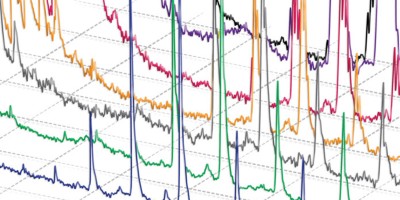Abstract
Functional assays of intracellular Ca2+ channels, such as the inositol 1,4,5-trisphosphate receptor (IP3R), have generally used 45Ca2+-flux assays, fluorescent indicators loaded within either the cytosol or the endoplasmic reticulum (ER) of single cells, or electrophysiological analyses. None of these methods is readily applicable to rapid, high-throughput quantitative analyses. Here we provide a detailed protocol for high-throughput functional analysis of native and recombinant IP3Rs. A low-affinity Ca2+ indicator (mag-fluo-4) trapped within the ER of permeabilized cells is shown to report changes in luminal free Ca2+ concentration reliably. An automated fluorescence plate reader allows rapid measurement of Ca2+ release from intracellular stores mediated by IP3R. The method can be readily adapted to other cell types or to the analysis of other intracellular Ca2+ channels. This protocol can be completed in 2–3 h.




Similar content being viewed by others
References
Laude, A.J. et al. Rapid functional assays of recombinant IP3 receptors. Cell Calcium 38, 45–51 (2005).
Monteith, G.R. & Bird, G.S. Techniques: high-throughput measurement of intracellular Ca2+ — back to basics. Trends Pharmacol. Sci. 26, 218–223 (2005).
Tsien, R.Y. Fluorescent probes of cell signalling. Annu. Rev. Neurosci. 12, 227–253 (1989).
Tsien, R.Y. Imagining imaging's future. Nat. Rev. Mol. Cell Biol. 4, SS16–SS21 (2003).
Johnston, P.A. & Johnston, P.A. Cellular platforms for HTS: three case studies. Drug Discov. Today 7, 353–363 (2002).
Williams, D.A., Fogarty, K.E., Tsien, R.Y. & Fay, F.S. Calcium gradients in single smooth muscle cells revealed by the digital imaging microscope using fura-2. Nature 318, 558–561 (1985).
Hofer, A.M. & Machen, T.E. Technique for in situ measurement of calcium in intracellular inositol 1,4,5-trisphosphate-sensitive stores using the fluorescent indicator mag-fura-2. Proc. Natl. Acad. Sci. USA 90, 2598–2602 (1993).
Combettes, L., Cheek, T.R. & Taylor, C.W. Regulation of inositol trisphosphate receptors by luminal Ca2+ contributes to quantal Ca2+ mobilization. EMBO J. 15, 2086–2093 (1996).
Miyakawa, T. et al. Encoding of Ca2+ signals by differential expression of IP3 receptor subtypes. EMBO J. 17, 1303–1308 (1999).
Bygrave, F.L. & Benedetti, A. What is the concentration of calcium ions in the endoplasmic reticulum? Cell Calcium 19, 547–551 (1996).
Hofer, A.M. & Machen, T.E. Direct measurement of free Ca2+ in organelles of gastric epithelial cells. Am. J. Physiol. 267, G442–G451 (1994).
Simpson, A.W. Fluorescent measurement of [Ca2+]c: basic practical considerations. Methods Mol. Biol. 312, 3–36 (2006).
Invitrogen. Molecular Probes Handbook — A Guide to Fluorescent Probes and Labelling Technologies Tenth Edn. 〈http://probes.invitrogen.com/handbook/〉.
Taylor, C.W. in Calcium Signaling (ed. Putney, J.W.) p.p. 111–130 (CRC Press, Boca Raton, Florida, USA, 2000).
Winding, P. & Berchtold, M.W. The chicken B cell line DT40: a novel tool for gene disruption experiments. J. Immunol. Meth. 249, 1–16 (2001).
Suguwara, H., Kurosaki, M., Takata, M. & Kurosaki, T. Genetic evidence for involvement of type 1, type 2 and type 3 inositol 1,4,5-trisphosphate receptors in signal transduction through the B-cell antigen receptor. EMBO J. 16, 3078–3088 (1997).
Thomas, D. et al. A comparison of fluorescent Ca2+ indicator properties and their use in measuring elementary and global Ca2+ signals. Cell Calcium 28, 213–223 (2000).
Patel, S. & Taylor, C.W. Quantal responses to inositol 1,4,5-trisphosphate are not a consequence of Ca2+ regulation of inositol 1,4,5-trisphosphate receptors. Biochem. J. 312, 789–794 (1995).
Correa, V. et al. Structural determinants of adenophostin A activity at inositol trisphosphate receptors. Mol. Pharmacol. 59, 1206–1215 (2001).
Van Rossum, D.B. et al. Agonist-induced Ca2+ entry determined by inositol 1,4,5-trisphosphate recognition. Proc. Natl. Acad. Sci. USA 101, 2323–2327 (2004).
Acknowledgements
This work was supported by the Wellcome Trust, and the Biotechnology and Biological Sciences Research Council (BBSRC). We thank S. Lummis (Department of Biochemistry, Cambridge University, UK) for access to her FlexStation.
Author information
Authors and Affiliations
Corresponding author
Ethics declarations
Competing interests
The authors declare no competing financial interests.
Rights and permissions
About this article
Cite this article
Tovey, S., Sun, Y. & Taylor, C. Rapid functional assays of intracellular Ca2+ channels. Nat Protoc 1, 259–263 (2006). https://doi.org/10.1038/nprot.2006.40
Published:
Issue Date:
DOI: https://doi.org/10.1038/nprot.2006.40
- Springer Nature Limited
This article is cited by
-
Association of the IP3R to STIM1 provides a reduced intraluminal calcium microenvironment, resulting in enhanced store-operated calcium entry
Scientific Reports (2018)
-
Ca2+ signals initiate at immobile IP3 receptors adjacent to ER-plasma membrane junctions
Nature Communications (2017)
-
Structural and functional conservation of key domains in InsP3 and ryanodine receptors
Nature (2012)
-
Synthetic partial agonists reveal key steps in IP3 receptor activation
Nature Chemical Biology (2009)
-
Sequential phases of Ca2+ alterations in pre-apoptotic cells
Apoptosis (2007)





